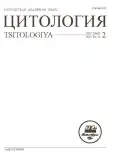Pericytes as an Essential Part in Transwell Models of the BBB in Vitro
- Authors: Mosiagina А.I.1, Khilazheva E.D.1, Morgun A.V.1
-
Affiliations:
- Research Institute of Molecular Medicine and Pathobiochemistry, Prof. V.F. Voino-Yasenetsky Krasnoyarsk State Medical University of the Ministry of Healthcare of the Russian Federation
- Issue: Vol 65, No 2 (2023)
- Pages: 200-205
- Section: Articles
- URL: https://journals.rcsi.science/0041-3771/article/view/140107
- DOI: https://doi.org/10.31857/S0041377123020050
- EDN: https://elibrary.ru/LWQJAN
- ID: 140107
Cite item
Full Text
Abstract
In this study we aimed to demonstrate the advantages of using a quadruple culture model of the blood-brain barrier (BBB) in vitro in comparison with a common triple culture model, as well as to show the impact of pericytes on endothelial cells of the BBB. We co-cultured primary rat brain microvascular endothelial cells (BMECs), pericytes, astrocytes and neurons in a Transwell BBB model in vitro. Then, we carried out quantitative analysis to compare transendothelial electrical resistance (TEER) values, as well as expression levels of tight junction proteins, ZO1 and JAM1, in the triple culture and the quadruple culture Transwell BBB models in vitro. According to the obtained data, the quadruple culture model of the BBB in vitro has advantages over the triple culture model, since the presence of pericytes is accompanied by higher TEER values and higher expression levels of tight junction proteins in endothelial cells. The results presented in the study are consistent with the world scientific literature and confirm the hypothesis that pericytes not only offer mechanical support for endothelial cells, but also play a key role in signaling networks between different cell types of the neurovascular unit (NVU) and thus regulate the barrier functions of the BBB. According to this, co-culture of BMECs, astrocytes, and neurons with pericytes is essential for BMECs optimum phenotype and offers a closer representation of the in vivo environment.
About the authors
А. I. Mosiagina
Research Institute of Molecular Medicine and Pathobiochemistry, Prof. V.F. Voino-Yasenetsky Krasnoyarsk State Medical University of the Ministry of Healthcare of the Russian Federation
Author for correspondence.
Email: angelina.mosiagina@gmail.com
Russia, 660022, Krasnoyarsk
E. D. Khilazheva
Research Institute of Molecular Medicine and Pathobiochemistry, Prof. V.F. Voino-Yasenetsky Krasnoyarsk State Medical University of the Ministry of Healthcare of the Russian Federation
Email: angelina.mosiagina@gmail.com
Russia, 660022, Krasnoyarsk
A. V. Morgun
Research Institute of Molecular Medicine and Pathobiochemistry, Prof. V.F. Voino-Yasenetsky Krasnoyarsk State Medical University of the Ministry of Healthcare of the Russian Federation
Email: angelina.mosiagina@gmail.com
Russia, 660022, Krasnoyarsk
References
- Хилажева Е.Д., Бойцова Е.Б., Пожиленкова Е.А., Солончук Ю.Р., Салмина А.Б. 2015. Получение трехклеточной модели нейроваскулярной единицы in vitro. Цитология. Т. 57. № 10. С. 710. (Khilazheva E.D., Boytsova E.B., Pozhilenkova E.A., Solonchuk Yu.R., Salmina A.B. 2015. The model of neurovascular unit in vitro consisting of three cells types. Cell Tiss. Biol. (Tsitologiya). V. 57. № 10. Р. 710.)
- Crouch E.E., Doetsch F. 2018. FACS isolation of endothelial cells and pericytes from mouse brain microregions. Nat. Protoc. V. 13. P. 738. https://doi.org/10.1038/nprot.2017.158
- Hatherell K., Couraud P.-O., Romero I.A., Weksler B., Pilkington G.J. 2011. Development of a three-dimensional, all-human in vitro model of the blood−brain barrier using mono-, co-, and tri-cultivation Transwell models. J. Neurosci. Methods. V. 199. P. 223. https://doi.org/10.1016/j.jneumeth.2011.05.012
- Liu Y., Xue Q., Tang Q., Hou M., Qi H., Chen G., Chen W., Zhang J., Chen Y., Xu X. 2013. A simple method for isolating and culturing the rat brain microvascular endothelial cells. Microvasc. Res. V. 90. P. 199. https://doi.org/10.1016/j.mvr.2013.08.00
- Nortley R., Korte N., Izquierdo P., Hirunpattarasilp C., Mishra A., Jaunmuktane Z., Kyrargyri V., Pfeiffer T., Khennouf L., Madry C., Gong H., Richard-Loendt A., Huang W., Saito T., Saido T.C. et al. 2019. Amyloid β oligomers constrict human capillaries in Alzheimer’s disease via signaling to pericytes. Science. V. 365. Article no. eaav9518. https://doi.org/10.1126/science.aav9518
- Nzou G., Wicks R.T., Wicks E.E., Seale S.A., Sane C.H., Chen A., Murphy S.V., Jackson J.D., Atala A.J. 2018. Human cortex spheroid with a functional blood brain barrier for high-throughput neurotoxicity screening and disease modeling. Sci. Rep. V. 8. P. 7413. https://doi.org/10.1038/s41598-018-25603-5
- Shin Y., Choi S.H., Kim E., Bylykbashi E., Kim J.A., Chung S., Kim D.Y., Kamm R.D., Tanzi R.E. 2019. blood–brain barrier dysfunction in a 3D in vitro model of Alzheimer’s disease. Adv. Sci. V. 6. P. 1900962. https://doi.org/10.1002/advs.201900962
- Srinivasan B., Kolli A.R. 2019. Transepithelial/transendothelial electrical resistance (TEER) to measure the integrity of blood−brain barrier. blood−brain barrier. Neuromethods. N.Y.: Humana Press. P. 142. https://doi.org/10.1007/978-1-4939-8946-1_6
- Stone N.L., England T.J., O’Sullivan S.E. 2019. A novel transwell blood brain barrier model using primary human cells. Front. Cell Neurosci. V. 13. P. 230. https://doi.org/10.3389/fncel.2019.00230
- Sweeney M.D., Ayyadurai S., Zlokovic B.V. 2016. Pericytes of the neurovascular unit: key functions and signaling pathways. Nat. Neurosci. V. 19. P. 771. https://doi.org/10.1038/nn.4288
- Yang S., Jin H., Zhu Y., Wan Y., Opoku E.N., Zhu L., Hu B. 2017. Diverse functions and mechanisms of pericytes in ischemic stroke. Curr. Neuropharmacol. V. 15. P. 892. https://doi.org/10.2174/1570159X15666170112170226
Supplementary files












